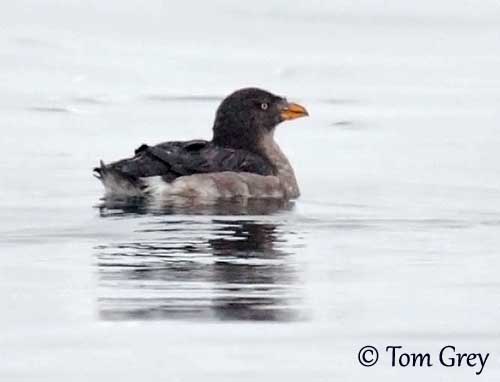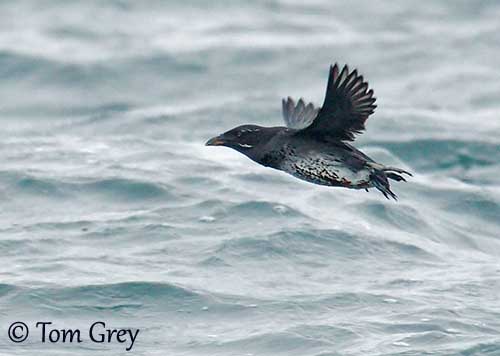
Fr : Macareux rhinocéros
Ang : Rhinoceros Auklet – Unicorn Auk or Puffin - Horn-billed Puffin
All : Nashornalk
Esp : Alca Unicórnea
Ita : Alca minore rinoceronte
Nd : Neushoornalk
Sd : Hornalka
Photographer:
Tom Grey
Tom Grey's Bird Pictures
Text by Nicole Bouglouan
Sources:
HANDBOOK OF THE BIRDS OF THE WORLD Vol 3 by Josep del Hoyo-Andrew Elliott-Jordi Sargatal - Lynx Edicions - ISBN : 8487334202
BirdLife International (BirdLife International)
What Bird-The ultimate Bird Guide (Mitchell Waite)
Wikipedia, the free encyclopaedia
Alaska Seabird Information Series
Rhinoceros Auklet
Cerorhinca monocerata
Charadriiformes Order – Alcidae Family
INTRODUCTION:
The Rhinoceros Auklet is the only extant member of the genus Cerorhinca. This medium-sized species has a robust bill with a whitish knob or “horn” in breeding plumage, giving the bird its name. It is also known as Unicorn Auk or Puffin.
In spite of its name “auklet”, this species is more related to the brightly coloured, parrot-billed puffins of genus Fratercula, than to the small plankton-feeding alcids called auklets of genus Aethia.
The Rhinoceros Auklet is mostly nocturnal, being active at night to avoid predation. It usually spends the day on the water.

DESCRIPTION OF THE BIRD:
Biometrics:
Length: 35-38 cm
Weight: 530 g
The adult has sooty-brown upperparts with pale buff-edged feathers, involving faint scaled pattern.
On the underparts, chin and throat are brown, whereas the upper breast is paler and mostly brownish. Flanks and belly are whitish with irregular pale brown barring.
The head is dark brown. We can see two long, white facial plumes extending backwards, one from above the eye to the nape, and the other from the gape to the side of the throat.
The robust bill is orange-yellow, with a short, white knob projecting vertically from the base of the upper mandible. The eyes are pale yellow-orange. Legs and webbed feet are dull yellow with black webs and claws.
Both sexes are similar. In winter, the white knob is absent and the white facial plumes are reduced and less conspicuous.
The juvenile resembles non-breeding adult. It has smaller, duller bill, and the white facial plumes are absent. The eyes are dark brown.

RANGE:
The Rhinoceros Auklet breeds from Japan in the west, to the Gulf of Alaska in the east, and south to southern California.
In Alaska, it breeds in the Semidi islands on Chowiet Island, Middleton and the Chiswell Islands in the Gulf of Alaska, and St Lazaria and Forrester Islands in SW Alaska.
A small population of about 30 birds probably breeds on Buldir Island in the Aleutian Islands.
Another breeding colony established on Sud Island in the Barren islands was absent in 1994, although the species is still present in summer around these islands, suggesting that they are still breeding in this area.
The Rhinoceros Auklets breeding outside N America remain near their breeding range, but they can be seen as far as Tokyo, and occasionally Kyushu and NE China.
The North American breeders winter in Pacific waters, from SE Alaska to S Baja California.

HABITAT:
The Rhinoceros Auklet breeds on grassy slopes, both maritime and inland, or on flat ground on small predator-free islands. It rarely breeds on mainland cliffs or on steep islands. They occur in sheltered bays at night where they form large roosting flocks.
During winter, it is found offshore from its breeding areas, or in suitable coastal waters with abundant food sources.
CRIS ET CHANTS:
The Rhinoceros Auklet produces low growling notes at nest. At night, it gives several “mooing” notes while approaching the colony, in order to locate its mate. We can also hear short-rapid barks.
BEHAVIOUR IN THE WILD:
The Rhinoceros Auklet feeds on small fish, squid, krill and crustaceans. It dives from the surface and propels itself underwater with the wings.
Unlike the other auks, this one carries the fish crosswise in the bill, whereas other species carry the food in their gular pouch. The chicks are fed mainly on fish, and later on invertebrates too.
The Rhinoceros Auklet forages inshore in mixed species flocks, both near the breeding colonies and far offshore.

It breeds in colonies on isolated islands. They are monogamous with probably high site and mate fidelity. They nest in burrows excavated in grassy slopes, or they use rock crevices, according to the nest-site availability.
There is no information about the courtship displays, but we can suggest that the facial ornaments play a role in courtship while the male displays by bowing the head to invite billing. Mate-guarding is probably performed by the male to protect the female against rivals.
The Rhinoceros Auklet winters usually within the breeding range, and the southern populations may be sedentary and remain in adjacent waters. The northern birds are mostly migratory and move southwards.
This species needs a slope for easier take-off, but once in the air, the flight is fast and direct, with rapid wingbeats.

REPRODUCTION OF THIS SPECIES:
The breeding season occurs between late March/early April and Late July/early September, with the laying from April to mid-June.
The Rhinoceros Auklet breeds in small to large colonies, usually with other species of Alcids.
Both adults dig the burrow with the beak and the claws. The burrow is excavated in grassy slopes or in flat ground on the forest floor. This burrow can be up to 2-3 to 6 metres long. At the end there is the nest-chamber where the birds build a loose platform with sticks, grass, moss and feathers.
The female lays a single egg, and both adults incubate during 35 days in shifts of 24 hours. At hatching, the chick has dark greyish-brown down above, paler below. It is fed by its parents with small fish and squid brought in the bill each night, to avoid predation and kleptoparasitism from other seabirds.
The young fledge about 52 days after hatching (between 48 and 60 days according to the food resources). It leaves the nest and the colony at night and flies alone to the sea.

PROTECTION / THREATS / STATUS:
The Rhinoceros Auklet is threatened by introduced predators and gulls at breeding colonies, oil pollution at sea in the vicinity of the major colonies, drowning in fishing nets and human disturbance at colonies during summer.
The global population is estimated at about 1,300,000 individuals, and suspected to be in decline due to predation by invasive species.
But currently, the Rhinoceros Auklet is evaluated as Least Concern.
